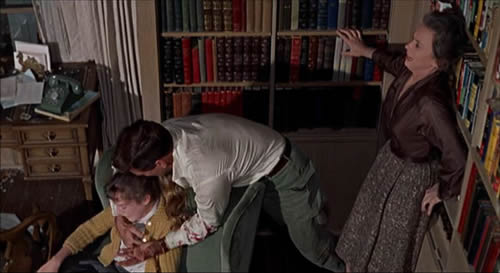Melanie's Coercion by the Birds
The Attack on the House and the Escape

The sound in The Birds often comes from unseen sources, which serves to make the threat of the birds more immediate to the viewer. For example, in the final attack on the living room, only one or two birds are actually seen, but the diegetic bird sounds are heard throughout the scene. It is the soundtrack that is frightening here, not the visuals. This also creates a connection between the viewer and what they are seeing on the screen. The lines between film and reality have been blurred. One can't help but wonder if the noises they are hearing might actually be coming from inside the theater. Could the theater and thus the viewer actually be under attack? The viewer becomes directly involved in the terror of the characters on the screen, feeling not only sympathy for them but perhaps empathy as well. Hitchcock's concerted efforts to make the threat of the birds more real could then be an effort to make the viewer understand the proximity of the threat that shifting gender roles can pose on society.

The escape scene at the very end of the movie is another prime example of the power diegetic noise can hold. While the viewers fear in this scene is primarily motivated by the presence of a sea of birds outside the door of the house and around the car, the sound plays an important role in showing how arbitrary and imminent the attacks can be. Throughout the scene there is a low murmur of birds cooing with occasional squawks breaking through when the characters get too close to a bird. The constant presence of the murmuring birds serves as a reminder to the viewer that the birds could strike at any moment and without warning. Ultimately this heightens the fear that the viewer is experiencing. As the car drives away the bird noises become louder and louder indicating that Bodega Bay has been finally overrun by the threat of shifting gender politics that Melanie brought with her two days before.